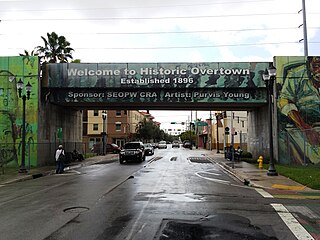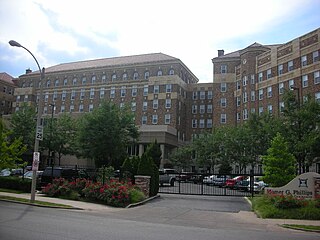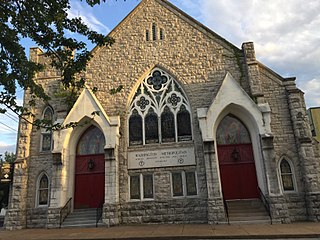Boone County

This list of African American Historic Places in Missouri is based on a book by the National Park Service, The Preservation Press, the National Trust for Historic Preservation, and the National Conference of State Historic Preservation Officers. [1]
| Boone - Cooper - Franklin - Jackson - Lewis - Marion - Newton - St. Louis - Saline |
Some of these sites are on the National Register of Historic Places (NR) as independent sites or as part of larger historic district. Several of the sites are National Historic Landmarks (NRL). Others have Missouri historical markers (HM). The citation on historical markers is given in the reference. The location listed is the nearest community to the site. More precise locations are given in the reference.





Overtown is a neighborhood of Miami, Florida, United States, just northwest of Downtown Miami. Originally called Colored Town in the Jim Crow era of the late 19th through the mid-20th century, the area was once the preeminent and is the historic center for commerce in the black community in Miami and South Florida.

The Ville is a historic African-American neighborhood with many African-American businesses located in North St. Louis, Missouri, U.S.. This neighborhood is a forty-two-square-block bounded by St. Louis Avenue on the north, Martin Luther King Drive on the south, Sarah on the east and Taylor on the west. From 1911 to 1950, The Ville was the center of African American culture within the city of St. Louis.

America's 11 Most Endangered Places or America's 11 Most Endangered Historic Places is a list of places in the United States that the National Trust for Historic Preservation considers the most endangered. It aims to inspire Americans to preserve examples of architectural and cultural heritage that could be "relegated to the dustbins of history" without intervention.

Save America's Treasures is a United States federal government initiative to preserve and protect historic buildings, arts, and published works. It is a public–private partnership between the U.S. National Park Service and the National Trust for Historic Preservation. The National Endowment for the Arts, National Endowment for the Humanities, and Institute of Museum and Library Services are also partners in the work. In the early years of the program, Heritage Preservation and the National Park Foundation were also involved.

Quinn Chapel AME Church is a historic African Methodist Episcopal Church building located at 227 Bowen Street in the Carondelet section of St. Louis, Missouri, in the United States. Built in 1869 as the North Public Market, it was acquired by the church in 1880. On October 16, 1974, it was added to the National Register of Historic Places. Its current pastor is Rev. Lori K. Beason.

Hayti, also called Hayti District, is the historic African-American community that is now part of the city of Durham, North Carolina. It was founded as an independent black community shortly after the American Civil War on the southern edge of Durham by freedmen coming to work in tobacco warehouses and related jobs in the city. By the early decades of the 20th century, African Americans owned and operated more than 200 businesses, which were located along Fayetteville, Pettigrew, and Pine Streets, the boundaries of Hayti.

John Berry Meachum was an American pastor, businessman, educator and founder of the First African Baptist Church in St. Louis, the oldest black church west of the Mississippi River. At a time when it was illegal in the city to teach people of color to read and write, Meachum operated a school in the church's basement. Meachum also circumvented a Missouri state law banning education for black people by creating the Floating Freedom School on a steamboat on the Mississippi River.
Herman H. Dreer (1888–1981) was an American academic administrator, educator, educational reformer, activist, author, editor, Baptist minister, and civil rights leader. He is best known for writing curriculum and programming for teaching African American History at most grade levels for early 20th-century public schools. Dreer is also credited with initiating Black History Month observance in the United States, alongside Carter G. Woodson.
The African American Cultural Heritage Action Fund is a program formed in 2017 to aid stewards of Black cultural sites throughout the nation in preserving both physical landmarks, their material collections and associated narratives. It was organized under the auspices of the National Trust for Historic Preservation. The initiative which awards grants to select applicants and advocates of Black history has been led by architectural historian Brent Leggs since 2019. It is the largest program in America to preserve places associated with Black history.

Washington Metropolitan African Methodist Episcopal Zion Church is a religious organization and historic church building in St. Louis, Missouri, U.S.. The building originally housed the United Methodist Episcopal Church. It is one of the few surviving examples of Gothic Revival churches in St. Louis. It has been listed as one of the National Register of Historic Places since 2005, for the architecture.